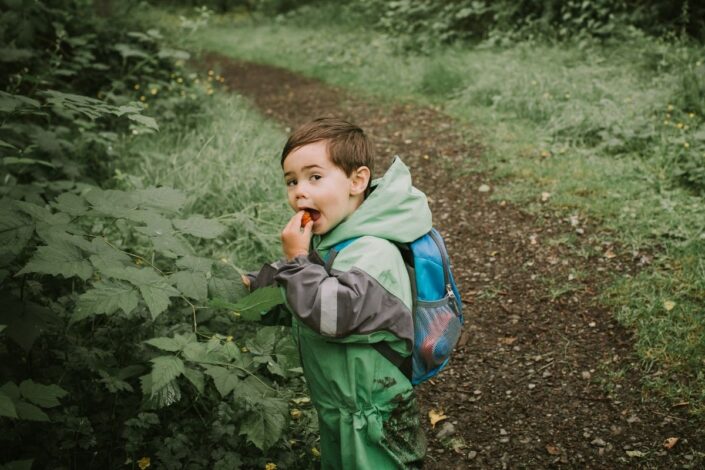Exploring Nature with Your Senses: Taste
- Blog Exploring Nature with Your Senses: Taste
While wandering through nature, we take in our surroundings using our senses. We smell flowers, touch tree bark, listen to bird calls, see details (like an ant trail on a tree), and even taste some of the natural objects we come across (think berries or edible flowers). And, while investigating nature in this way comes naturally to most children, sometimes we forget to allow children the time and space they need to do it.
We are sharing five different ways to explore each of the five senses with children. So get outside as a family, slow down, and explore nature with your senses together!

Photo Credit: Ashley Schneider
Exploring Nature through Taste
Tasting nature is probably not the first thing you think about when you head out to explore. In fact, with kids, tasting nature is probably one of the things you actively try to avoid. But, as the saying goes, knowledge is power. So, keeping in mind that not all nature is edible and that children around 2-3 years of age can understand this concept (this age will vary and you know your child best), using taste to explore nature can be a fun adventure all its own.
Five ways to slow down and experience the sense of taste in nature:
- Taste of farmer's markets. Farmers markets are the perfect place to introduce kids of any age to a variety of foods grown locally. Just because it is from a farm or garden, does not mean it is not a part of nature. Almost all fruits, nuts, and veggies grew wild at one point or another and many still do. So go on a tasting spree at your local farmer's market. Sample a variety of food each time or have your child pick on new food to try each time you go. Plus, this activity connects the food you eat to the earth and the people that grew it, which is a wonderful bonus.
- Go foraging. Foraging is a fun way to immerse yourselves in nature and find edible food in the wild. Kids love picking food right off the plant and being able to give it a try. New to foraging and not sure what you can eat safely? There are a variety of books and websites dedicated to this very topic, so if you are unsure what wild plants are edible or not, please read up on it before you go.
- Cook with edible flowers. So many flowers are edible and there are a variety of ways to cook with them. Dandelions are popular because they are virtually available everywhere and add an earthy note and a spot of color to cookies. Check out this recipe from Adamant Kitchen. But really, there are so many edible flowers out there, you may not need to look far to find one near you. Here is a list of edible flowers and Google will be your friend in finding a recipe.
- Go to a u-pick farm. Foraging in the wild is not for everyone, but utilizing a local u-pick farm is another way to do the same sort of thing. Your children are able to pick fruit and veggies right off the plant and taste each one at its freshest. Some children are more likely to give the food they collect a taste too, which is an added benefit.
- Play what is that taste. No need to leave the home or hit up the local farmers market or grocery store for this one (though it might be fun to throw in a dragon fruit or rosemary sprig for fun). Just go through your kitchen and select a few fresh food items (herbs, fruit, veggies, nuts, etc.) for the game. You can also use edible flowers and other foraged foods if you have access to them. Have your children close their eyes (or use a blindfold) and place some of each food item into your child’s mouth. They will enjoy guessing what each food item is and may even discover a new food they like. Try to use several foods your kids are familiar with, but also try to throw in a couple they may not know. You can give hints like it grows in the ground or it's a red food if that will be helpful. The point is to have fun and taste a little bit of nature in the process.
Want to learn more about exploring nature with your senses? Check out the rest of this series here: smelling, hearing, touching and seeing.
ABOUT OUTGROWN
OutGrown is a 501(c)(3) nonprofit that works to create a world where everyone can enjoy the physical and mental benefits of spending time outside. We are focused on creating opportunities and removing barriers to access so families with babies and young children can take their first steps outside. We believe all families have the right to connect with nature, benefit from spending time outdoors and be inspired to a lifelong love of nature. Since its grassroots inception in 2013, OutGrown is a growing community of 280,000 families and over 300 volunteer Branch Ambassadors. More information on all of our programs can be found at WeAreOutGrown.org
EDITORS NOTE:
We hope you enjoyed reading this article from OutGrown. We’re working hard to provide our community with content and resources that inform, inspire, and entertain you.
But content is not free. It’s built on the hard work and dedication of writers, editors, and volunteers. We make an investment in developing premium content to make it easier for families with young children to connect with nature and each other. We do not ask this lightly, but if you can, please make a contribution and help us extend our reach.
Related Content





Comments